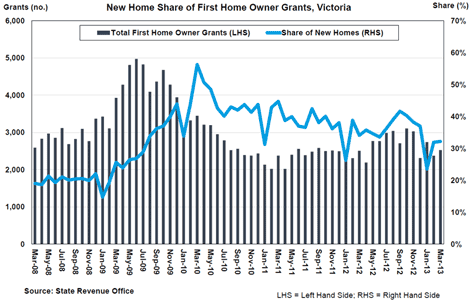It's time to stop tinkering with first-home buyer assistance: Robert Larocca

The changes to first home buyer assistance announced by the Victorian state government on the weekend continues the trend set the by previous Labor government of using financial incentives to modify buyer choices. This scenario is not uncommon across Australia.
With around nine separate changes made to first home buyer assistance over the past five years in Victoria, most planning to buy a new home would be right to be a little confused and wondering what will happen next. Many will have to save more; some will try and bring purchases forward.
A visit to the SRO website clearly shows policies for first home buyers are constantly changing. In the past few years, we have seen a variety of approaches to helping first home buyers, including:
- those buying an existing home for less than $600,000 received direct assistance of $17,000 but faced full stamp duty bills (late 2008-mid 2009);
- those buying an existing home in regional Victoria for less than $600,000 received direct assistance of $36,500 but faced full stamp duty bills (mid 2009-late 2009);
- those buying any home for less than $600,000 received $7,000 in direct assistance and a stamp duty cut of between 20 and 40 per cent (last two years);
- those buying an existing home in Melbourne for less than $600,000 received direct assistance of $18,000 but faced full stamp duty bills (first half of 2010).
Over the same time, and in response to these changes, we have seen the share of loans taken out by first home buyers be as high as 31.6% and as low as 16.3%. In February, it was 17.5%, lower than the 20-year average of 21.9%.
Click to enlargeNot only has the overall number of first home buyers changed, but so too has their choice of dwelling. Before governments provided higher assistance for those buying new homes, the share of grants for new homes comprised 20% of all purchases. In response to very high levels of assistance just for new homes, this share rose to around 56%. Most recently, it has been 30%.
Click to enlargeSource: SRO, REIV
Governments know that first home buyers are very price-sensitive and they will respond to financial incentives. Indeed, in the short term, we expect a rise in the number of first home buyers who seek to avoid losing the $7,000 grant on established homes. This happened last year in Victoria when the ‘builders bonus’ ended and in New South Wales as well.
Each of the changes has an impact on the market and forces first home buyers to reevaluate their position. From the REIV’s perspective, it really is time that the government stopped tinkering with first home buyer assistance.
The REIV called for, and strongly supported, the introduction of stamp duty cuts as they are an efficient and easily understood way of helping first home buyers. They recognize that the single biggest transactional expense when buying your first home is stamp duty. Indeed, many first home buyers must feel like they spend years saving to pay stamp duty (it makes sense to reduce this impost because first home buyers just don’t have the equity that those buying their second or third home do).
The progressive introduction of the stamp duty cuts was also very sensible as it didn’t provide any shock to the market.
This latest change, where the majority of first home buyers will be worse off, should be the stimulus for a reassessment of how first home buyers are assisted by governments. There seems to be little point of working to make housing more affordable through ensuring adequate levels of supply if, at the same time, the net levels of financial assistance are reduced.
The changes, as they apply to established homes, effectively reverse most of a 25 point cut in interest rates, seemingly running counter to the monetary policy decisions of the Reserve Bank.
With that in mind, surely the simplest and most efficient option for governments would be to charge first home buyers no stamp duty whilst ensuring adequate levels of supply.
Robert Larocca is policy and public affairs manager at the Real Estate Institute of Victoria.

